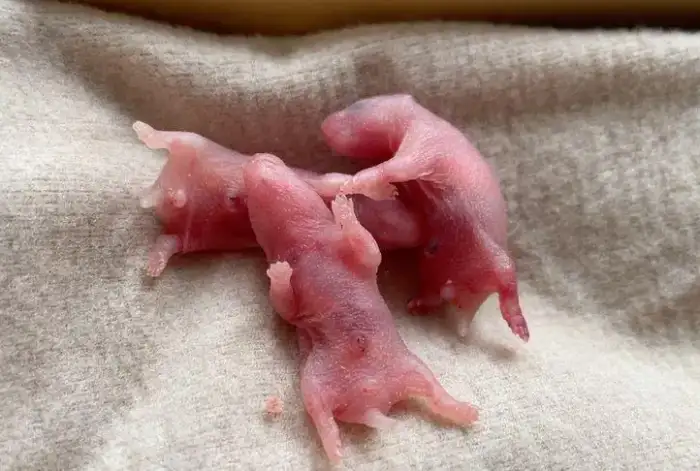Having a hamster give birth can be both an exciting and overwhelming experience for pet owners. Whether you’re a seasoned hamster enthusiast or a first-time owner, understanding how to care for the new babies and their mother is crucial. This guide will help you navigate the process of caring for newborn hamsters and ensuring the well-being of the entire family.

1. Understanding Hamster Pregnancy
Signs Your Hamster Is Pregnant
Before the birth, it’s essential to recognize the signs of pregnancy in hamsters. Some common indicators include:
- Increased appetite
- Nesting behavior (e.g., collecting bedding materials)
- Weight gain or a noticeable belly
If you suspect your hamster is pregnant, it’s vital to prepare for the arrival of the babies.
Gestation Period for Hamsters
Hamster gestation typically lasts around 16 to 22 days, depending on the breed. Dwarf hamsters usually have shorter gestation periods compared to larger breeds. Understanding the timeline can help you prepare for the birth.
2. Preparing for the Birth
Setting Up a Comfortable Environment
Before your hamster gives birth, ensure her living environment is comfortable and stress-free. Provide ample bedding and a nesting box, which will help her feel secure. Avoid disturbing her habitat during this time to minimize stress.
Nutrition for the Expecting Mother
A pregnant hamster requires a well-balanced diet to support both herself and her babies. Focus on:
- High-quality hamster pellets
- Fresh fruits and vegetables
- Protein sources like cooked egg or mealworms
Ensure that she has access to fresh water at all times.
3. The Birth Process
What to Expect During Birth
When the time comes for your hamster to give birth, you may notice her becoming more restless. The actual birthing process can take a few hours, and it’s crucial to allow her to do this without interference. Avoid touching the mother or her babies immediately after birth to prevent stress.
Identifying Newborn Hamsters
Newborn hamsters are typically hairless, blind, and very small. They will rely on their mother for warmth and nourishment. It’s essential to give the mother space and not disturb the nest.
4. Post-Birth Care for the Mother
Providing a Stress-Free Environment
After giving birth, the mother needs a quiet and safe environment. Limit handling and interaction to prevent stress. If you must check on her, do so gently and quickly.
Monitoring the Mother’s Health
Keep an eye on the mother for any signs of distress or health issues. If she appears lethargic, refuses to eat, or shows signs of infection, consult a veterinarian immediately.
5. Caring for Newborn Hamsters
When to Handle the Babies
It’s crucial to wait at least two weeks before handling the newborn hamsters. During this time, they will grow and develop, and handling them too early can cause stress to both the mother and the babies.
Feeding the Newborns
Newborn hamsters rely on their mother’s milk for nutrition. Ensure that the mother is receiving adequate nutrition to support her lactation. You can provide extra food to help her maintain her energy levels.
6. Weaning the Baby Hamsters
When to Start Weaning
Baby hamsters can start the weaning process around three to four weeks of age. At this stage, they will begin to explore solid food, although they will still rely on their mother’s milk.
Introducing Solid Foods
Introduce small amounts of high-quality hamster pellets, fresh fruits, and vegetables. Monitor their eating habits and ensure they are getting enough nutrition.
7. Finding Homes for the Babies
Determining the Right Time to Rehome
Baby hamsters can typically be adopted out at around six weeks of age. At this point, they should be fully weaned and capable of eating solid food independently.
Tips for Finding Responsible Homes
When looking for homes for your baby hamsters, consider the following:
- Screen potential adopters to ensure they have the knowledge and resources to care for hamsters.
- Provide information about proper care and housing requirements.
- Offer to take the babies back if the new owners can no longer care for them.
8. Preparing for Future Litters
Spaying and Neutering
If you do not plan to breed your hamsters again, consider spaying or neutering to prevent unexpected litters in the future. Consult with a veterinarian about the best options.
Understanding Responsible Breeding Practices
If you choose to breed hamsters, ensure that you do so responsibly. Educate yourself about genetics, proper care, and the importance of finding suitable homes for the offspring.
9. Conclusion: The Joys and Challenges of Hamster Parenthood
Celebrating New Life
Having a litter of baby hamsters can be a rewarding experience. By preparing and providing proper care for both the mother and her babies, you can help ensure a healthy and happy family.
Staying Informed
Continually educate yourself about hamster care and behavior. Resources like books, online forums, and veterinary advice can help you become a better hamster owner.

Comments (0)